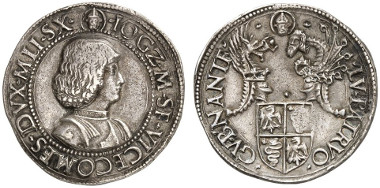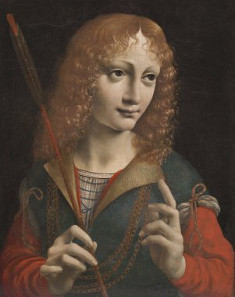courtesy of the MoneyMuseum, Zurich
translated by Teresa Teklic
Why was the human head the motif on coins for centuries, no, for millennia? And why did that change in the last 200 years? Ursula Kampmann is looking for answers to these questions in her book “Menschengesichter” (“Human faces”), from which the texts in this series are taken.
Milan. Giovanni Galeazzo Maria Sforza (1476-1494). Testone. Armour-clad bust of Giovanni to the right, above, on an escutcheon, frontal view of bust of Saint Ambrose. Rv. Milan coat of arms, above, two crested helmets, below, the inscription “Under the reign of Ludovico, his paternal uncle”. © MoneyMuseum, Zurich.
Only 33 years old was Galeazzo Maria Sforza when, on entering a church, he was thrice stabbed with a dagger in his chest by a young aristocrat. Following in the footsteps of the tyrannicides Brutus and Cassius, the young man had planned to murder the Duke and re-establish a republic, like the one in the interim between the last Visconti’s rule and the takeover by the Sforza.
But times had changed. Instead of celebrating him as a hero, an angry mob chased their Duke’s murderer through the city. He was captured, tortured, executed and his head impaled on a pole.
Giovanni Ambrogio de Predis, Allegedly, portrait of Giovanni Galeazzo Maria Sforza as Saint Sebastian. Source: Wikicommons.
Left behind was Giovanni Galeazzo Maria Sforza, minting authority of our coin and the son of the assassinated Duke. Only seven years old, he was too young to rule and a fight about the question who was to govern in his stead broke out. It’s hard to believe but some conflicts were actually solved peacefully in Italy at the time. In this case, the Milanese called in an arbitrator from Mantua to settle the dispute, who decreed that the child’s mother, Bona of Savoy, was to rule in his stead. All five brothers of the deceased Duke had to pledge their loyalty to the dowager duchess.
Unfortunately, Bona wasn’t clever enough to shape the politics of such an important dukedom alone. She relied on her advisors, lost large territories in a war and, as if that wasn’t enough, fell in love with the wrong man. He must have been one of the servants at the evening meal holding the honourable office of the carver. It’s not that people would have minded the dowager duchess’s little sexual adventure much, but did she really have to do it in public?
That only provided the long-awaited opportunity for Galeazzo Maria Sforza’s brothers to challenge the arbitration award. Ludovico Sforza, called “il Moro”, and his brother Ascanio, Bishop of Pavia, seized this opportunity. They forced Bona of Savoy to cede the guardianship of her son. Her lover was sent away, several of her advisors executed and the dowager duchess banned to her castle.
In 1480, young Giovanni Galeazzo Maria was declared to be of full age. But although that technically made him the sole holder of power, the young man preferred to amuse himself privately and left the government business to his uncle “il Moro”. After Galeazzo’s unexpected death 14 years later, “il Moro” finally also inherited the title of Duke of Milan, after he had de facto already been holding the position for many years.
And because it never gets boring with the Sforza dynasty, we’ll continue with Ludovico Sforza, “il Moro”, next time.
You can find all episodes in the series here.
A German edition of the book “Menschengesichter” is available in print and as ebook on the site of the Conzett Verlag.







